Moeness G. Amin
Index Modulation for Integrated Sensing and Communications: A Signal Processing Perspective
Jan 16, 2024



Abstract:A joint design of both sensing and communication can lead to substantial enhancement for both subsystems in terms of size, cost as well as spectrum and hardware efficiency. In the last decade, integrated sensing and communications (ISAC) has emerged as a means to efficiently utilize the spectrum on a single and shared hardware platform. Recent studies focused on developing multi-function approaches to share the spectrum between radar sensing and communications. Index modulation (IM) is one particular approach to incorporate information-bearing communication symbols into the emitted radar waveforms. While IM has been well investigated in communications-only systems, the implementation adoption of IM concept in ISAC has recently attracted researchers to achieve improved energy/spectral efficiency while maintaining satisfactory radar sensing performance. This article focuses on recent studies on IM-ISAC, and presents in detail the analytical background and relevance of the major IM-ISAC applications.
Sparse Array Capon Beamformer Design Availing Deep Learning
Aug 20, 2021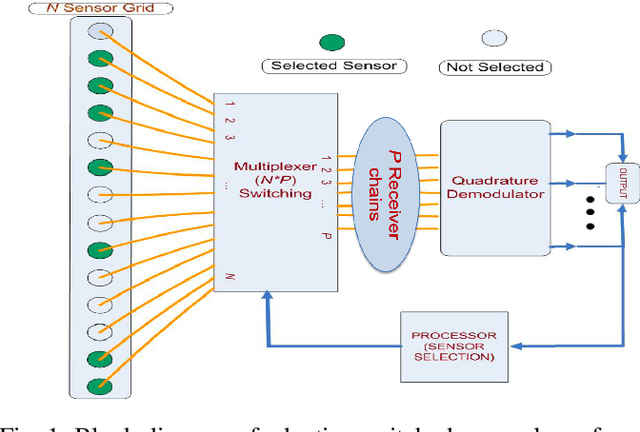

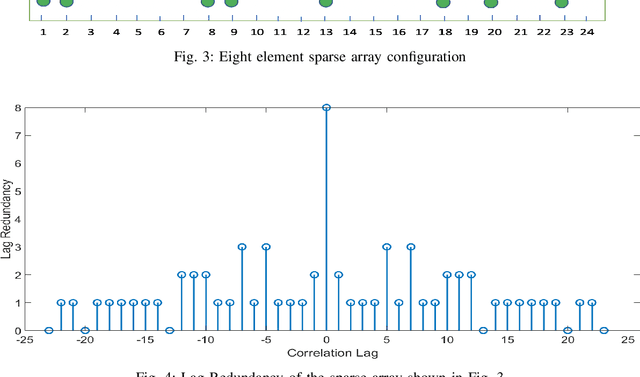
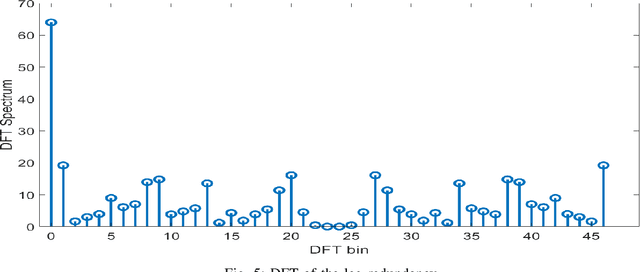
Abstract:The paper considers sparse array design for receive beamforming achieving maximum signal-to-interference plus noise ratio (MaxSINR). We develop a design approach based on supervised neural network where class labels are generated using an efficient sparse beamformer spectral analysis (SBSA) approach. SBSA uses explicit information of the unknown narrowband interference environment for training the network and bears close performance to training using enumerations, i.e., exhaustive search which is computationally prohibitive for large arrays. The employed DNN effectively approximates the unknown mapping from the input received data spatial correlations to the output of sparse configuration with effective interference mitigation capability. The problem is posed as a multi-label classification problem where the selected antenna locations achieving MaxSINR are indicated by the output layer of DNN. In addition to evaluating the performance of the DNN in terms of the classification accuracy, we evaluate the performance in terms of the the ability of the classified sparse array to mitigate interference and maximize signal power. It is shown that even in the case of miss-classification, where at least one sensor location doesn't match the optimal locations, the DNN effectively learns the sub-optimal sparse configuration which has desirable SINR characteristics. This shows the ability of the DNN to learn the proposed optimization algorithms, hence paving the way for efficient real-time implementation.
Cognitive-Driven Optimization of Sparse Array Transceiver for MIMO Radar Beamforming
Mar 04, 2021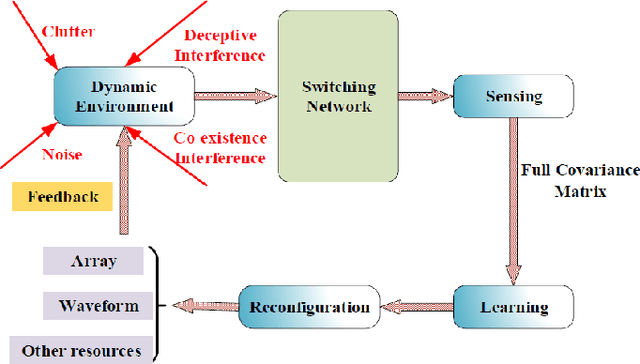


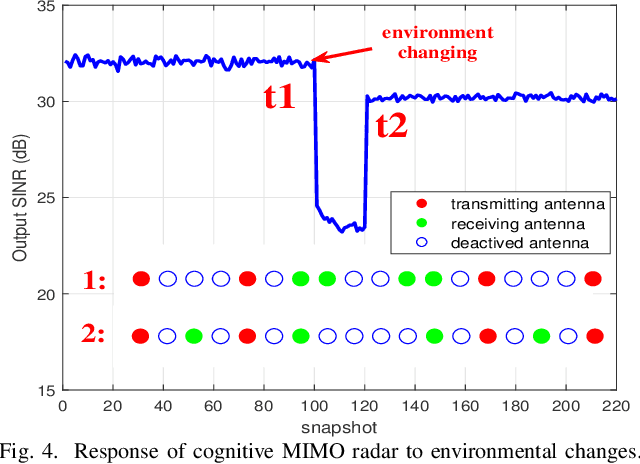
Abstract:Cognitive multiple-input multiple-output (MIMO) radar is capable of adjusting system parameters adaptively by sensing and learning in complex dynamic environment. Beamforming performance of MIMO radar is guided by both beamforming weight coefficients and the transceiver configuration. We propose a cognitive-driven MIMO array design where both the beamforming weights and the transceiver configuration are adaptively and concurrently optimized under different environmental conditions. The perception-action cycle involves data collection of full virtual array, covariance reconstruction and joint design of the transmit and receive arrays by antenna selection.The optimal transceiver array design is realized by promoting two-dimensional group sparsity via iteratively minimizing reweighted mixed L21-norm, with constraints imposed on transceiver antenna spacing for proper transmit/receive isolation. Simulations are provided to demonstrate the "perception-action" capability of the proposed cognitive sparse MIMO array in achieving enhanced beamforming and anti-jamming in dynamic target and interference environment.
Sparse Array Transceiver Design for Enhanced Adaptive Beamforming in MIMO Radar
Feb 20, 2021
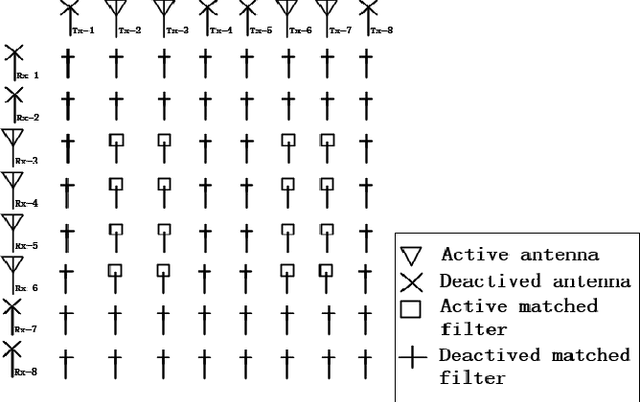

Abstract:Sparse array design aided by emerging fast sensor switching technologies can lower the overall system overhead by reducing the number of expensive transceiver chains. In this paper, we examine the active sparse array design enabling the maximum signal to interference plus noise ratio (MaxSINR) beamforming at the MIMO radar receiver. The proposed approach entails an entwined design, i.e., jointly selecting the optimum transmit and receive sensor locations for accomplishing MaxSINR receive beamforming. Specifically, we consider a co-located multiple-input multiple-output (MIMO) radar platform with orthogonal transmitted waveforms, and examine antenna selections at the transmit and receive arrays. The optimum active sparse array transceiver design problem is formulated as successive convex approximation (SCA) alongside the two-dimensional group sparsity promoting regularization. Several examples are provided to demonstrate the effectiveness of the proposed approach in utilizing the given transmit/receive array aperture and degrees of freedom for achieving MaxSINR beamforming.
Efficient Near-Field Imaging Using Cylindrical MIMO Arrays
Jan 22, 2021



Abstract:Multiple-input multiple-output (MIMO) array based millimeter-wave (MMW) imaging has a tangible prospect in applications of concealed weapons detection. A near-field imaging algorithm based on wavenumber domain processing is proposed for a cylindrical MIMO array scheme with uniformly spaced transmit and receive antennas over both the vertical and horizontal-arc directions. The spectrum aliasing associated with the proposed MIMO array is analyzed through a zero-filling discrete-time Fourier transform. The analysis shows that an undersampled array can be used in recovering the MMW image by a wavenumber domain algorithm. The requirements for the antenna inter-element spacing of the MIMO array are delineated. Numerical simulations as well as comparisons with the backprojection (BP) algorithm are provided to demonstrate the effectiveness of the proposed method.
RF Sensing for Continuous Monitoring of Human Activities for Home Consumer Applications
Mar 21, 2020



Abstract:Radar for indoor monitoring is an emerging area of research and development, covering and supporting different health and wellbeing applications of smart homes, assisted living, and medical diagnosis. We report on a successful RF sensing system for home monitoring applications. The system recognizes Activities of Daily Living(ADL) and detects unique motion characteristics, using data processing and training algorithms. We also examine the challenges of continuously monitoring various human activities which can be categorized into translation motions (active mode) and in-place motions (resting mode). We use the range-map, offered by a range-Doppler radar, to obtain the transition time between these two categories, characterized by changing and constant range values, respectively. This is achieved using the Radon transform that identifies straight lines of different slopes in the range-map image. Over the in-place motion time intervals, where activities have insignificant or negligible range swath, power threshold of the radar return micro-Doppler signatures,which is employed to define the time-spans of individual activities with insignificant or negligible range swath. Finding both the transition times and the time-spans of the different motions leads to improved classifications, as it avoids decisions rendered over time windows covering mixed activities.
* 12 pages
Motion Classification using Kinematically Sifted ACGAN-Synthesized Radar Micro-Doppler Signatures
Jan 19, 2020



Abstract:Deep neural networks (DNNs) have recently received vast attention in applications requiring classification of radar returns, including radar-based human activity recognition for security, smart homes, assisted living, and biomedicine. However,acquiring a sufficiently large training dataset remains a daunting task due to the high human costs and resources required for radar data collection. In this paper, an extended approach to adversarial learning is proposed for generation of synthetic radar micro-Doppler signatures that are well-adapted to different environments. The synthetic data is evaluated using visual interpretation, analysis of kinematic consistency, data diversity, dimensions of the latent space, and saliency maps. A principle-component analysis (PCA) based kinematic-sifting algorithm is introduced to ensure that synthetic signatures are consistent with physically possible human motions. The synthetic dataset is used to train a 19-layer deep convolutional neural network (DCNN) to classify micro-Doppler signatures acquired from an environment different from that of the dataset supplied to the adversarial network. An overall accuracy 93% is achieved on a dataset that contains multiple aspect angles (0 deg., 30 deg., and 45 deg. as well as 60 deg.), with 9% improvement as a result of kinematic sifting.
Radar Human Motion Recognition Using Motion States and Two-Way Classifications
Nov 08, 2019



Abstract:We perform classification of activities of daily living (ADL) using a Frequency-Modulated Continuous Waveform (FMCW) radar. In particular, we consider contiguous motions that are inseparable in time. Both the micro-Doppler signature and range-map are used to determine transitions from translation (walking) to in-place motions and vice versa, as well as to provide motion onset and the offset times. The possible classes of activities post and prior to the translation motion can be separately handled by forward and background classifiers. The paper describes ADL in terms of states and transitioning actions, and sets a framework to deal with separable and inseparable contiguous motions. It is shown that considering only the physically possible classes of motions stemming from the current motion state improves classification rates compared to incorporating all ADL for any given time.
 Add to Chrome
Add to Chrome Add to Firefox
Add to Firefox Add to Edge
Add to Edge